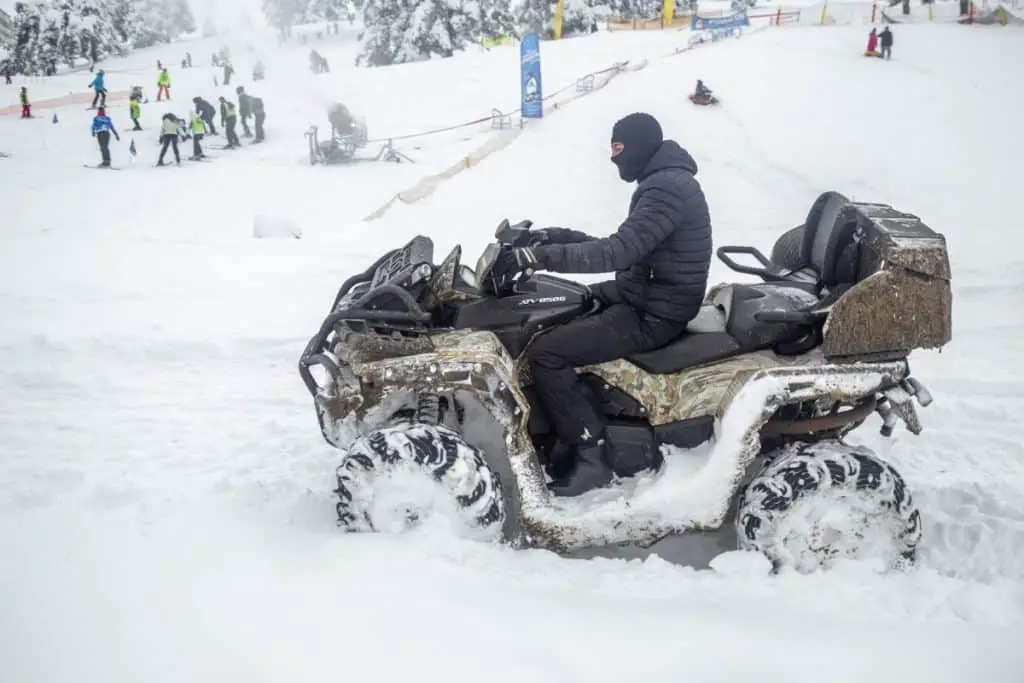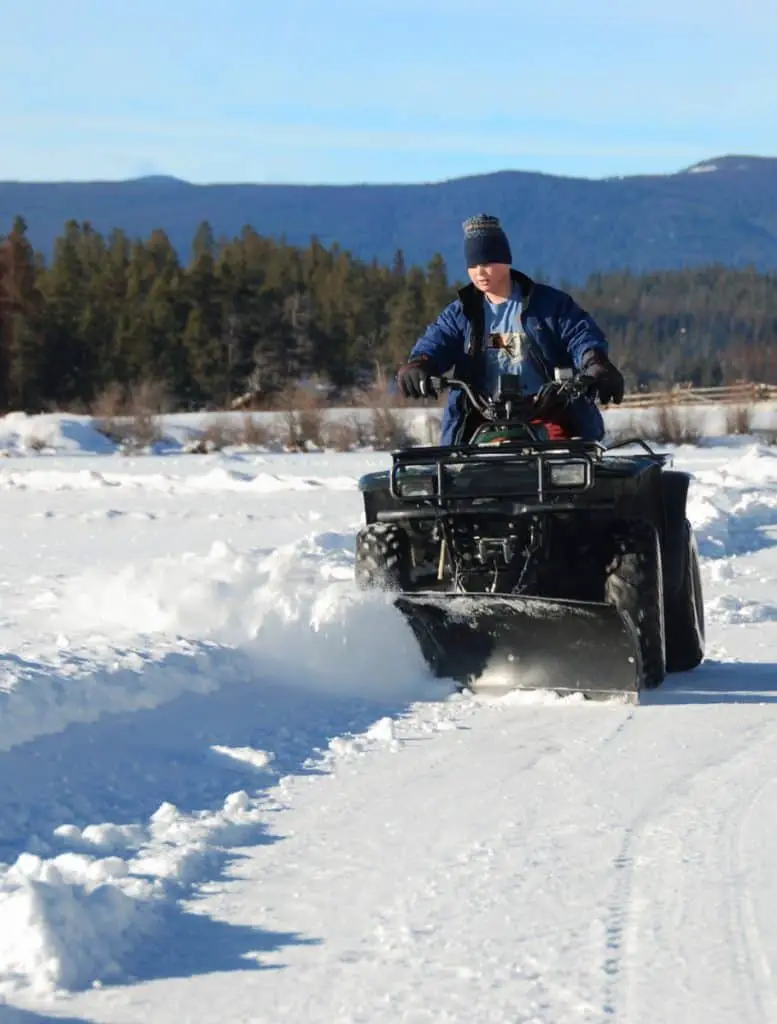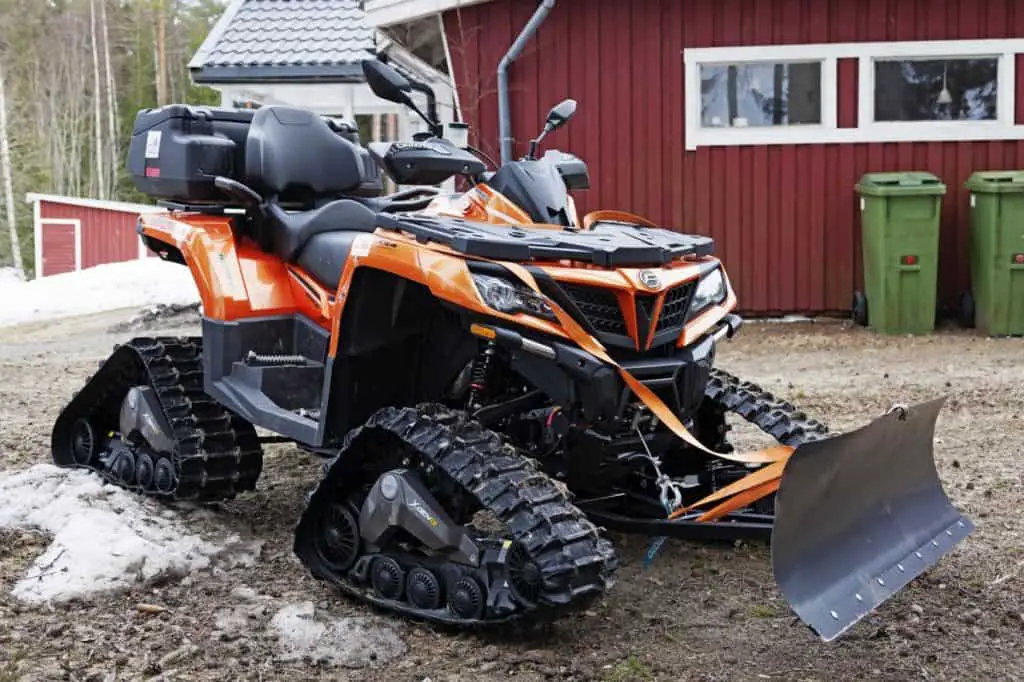Riding in an ATV in snow and ice is far easier in four-wheel drive. But, tire chains are known to provide much better traction than regular tires in snow and ice. So, I was curious if they work on an ATV, I looked into it, and here’s what I found.
Overall, ATV tires chains do work. They provide much better tractions in snow and ice. The tires will still spin occasionally, however, they spin much less. Tire chains also allow you to ride an ATV in 2 wheel drive where normally the conditions would required 4 wheel drive.
In this article, I will describe how well tire chains on and ATV work compared to riding in the same conditions without tire chains. As well as, how to install them, and what the owner’s manuals for ATVs say about using tire chains.

How Well Do ATV Tire Chains Work?
ATV tires chains work much better in snow and ice compared to regular ATV tires. Comparing both side by side, many people have found that ATV tires with chains on slip and spin much less in the snow and ice compared to ATV wires without.
The tires will still spin in the snow and ice, but far less than ATV tires without. Here’s a video that shows a comparison riding on the same snow and ice-covered hill using ATV tire chains, and with no ATV tire chains.
As you can see from the side-by-side comparison with no tire chains the wheels spun out, and wouldn’t come out of the hole in the snow they created. However, the tires without chains still perform OK. Another video is available here. The audio is a bit bad, but when tire chains were put on the ATV tires it performed MUCH better in the snow and ice than without.
Cautions about using tire chains on ATV tires
It’s not advisable to ride at high speed with tire chains on. The reason is that if the chains break a piece of the chain can fling itself into your ATV at extremely high speed. Which will likely cause significant damage to your ATV.
Chains are only good when they can get down to a hard surface. For example, if the snow is very thick, about over 4 feet (1.2 m), they won’t be able to get down to the hard surface underneath the snow before you’re virtually covered in snow.
The same is true for using tire chains in mud. The main advantage of chains is that they will provide more traction on surfaces that are slippery such as ice, and mud. But, if the snow cover or mud is so thick that you won’t get down to a firm base underneath they won’t help at all.
For incredibly deep know a snowmobile is generally a better option, however, an ATV with tracks installed on it can also work very well. I did a side-by-side comparison between a snowmobile and an ATV with tracks in this article.
Adding weight also helps a lot in the snow
Adding weight to your ATV when riding through snow works well because it pushes the tires into the surface giving the tires more grip. The main thing is to ensure any weight you add is secured well to the ATV. And also that the total weight isn’t too much and goes over the weight capacity of the ATV.
Water in containers can work well, but if you’ve got some old dumbbells lying around, they are much heavier for the size compared to water. You can remove the plates from the bar, and then strap them to the storage area on your ATV to add much more weight. Old car batteries are also very heavy and can work well.
Always check your owner’s manual to see what the weight capacity is for your ATV to ensure you’re not adding too much. Doing so can make it less stable, and wear out the engine a lot faster.

What ATV owner’s manuals say about using tire chains
I’ve looked through the owner’s manuals for the most popular ATV such as Honda, Polaris, and Yamaha. None of them make mention of tire chains, and whether they should or shouldn’t be used. In my opinion, since they don’t mention it, then it likely isn’t an important consideration, and so it’s perfectly fine to use them.
Do You Need Chains To Plow With an ATV?
Plowing snow can involve tight spaces where an ATV is better. And using a plow is much faster than shoveling snow by hand. However, you may be curious whether you need chains on the tires to plow with an ATV, here’s what I found.
Overall, you do not need tire chains to plow snow with an ATV. However, they do provide much better traction which makes it much easier. With practice, putting on or taking off tire chains on an ATV takes 5 minutes. So it’s generally better to use tire chains for both small and large areas.
Various videos at the top of this article show that an ATV with tire chains has much better traction in the snow and ice. This means the tires will spin less, and the job will be more efficient overall. The main concern is not to go too fast, as if a tire chain comes off or breaks it will whip into the wheel hub or the side of your ATV which can be extremely dangerous.

How Tight Should ATV Tire Chains Be?
Tire chains provide much better traction in slippery conditions. They can be installed loosely, or quite tight. So, I thought I’d answer how tight ATV tire chains should be.
ATV tires chains should be as tight as reasonably possible. This provides the best traction. From a stopped position, looser tire chains will be pulled back as the tire turns, and the tire will make more contact with the ground surface. This gives less traction.
This is best explained using a simple timeline for loose tire chains:
- The tires begin turning
- The force of the tire turning pulls the chain in the opposite direction the tire is turning
- The wheel surface turns on the ground surface
- The tire chain makes contact with the ground surface and provides extra grip.
If you compare that to tight tire chains, the tire chain remains fixed and doesn’t move back in the opposite direction of the tire before making contact with the ground surface. This gives better traction overall.
